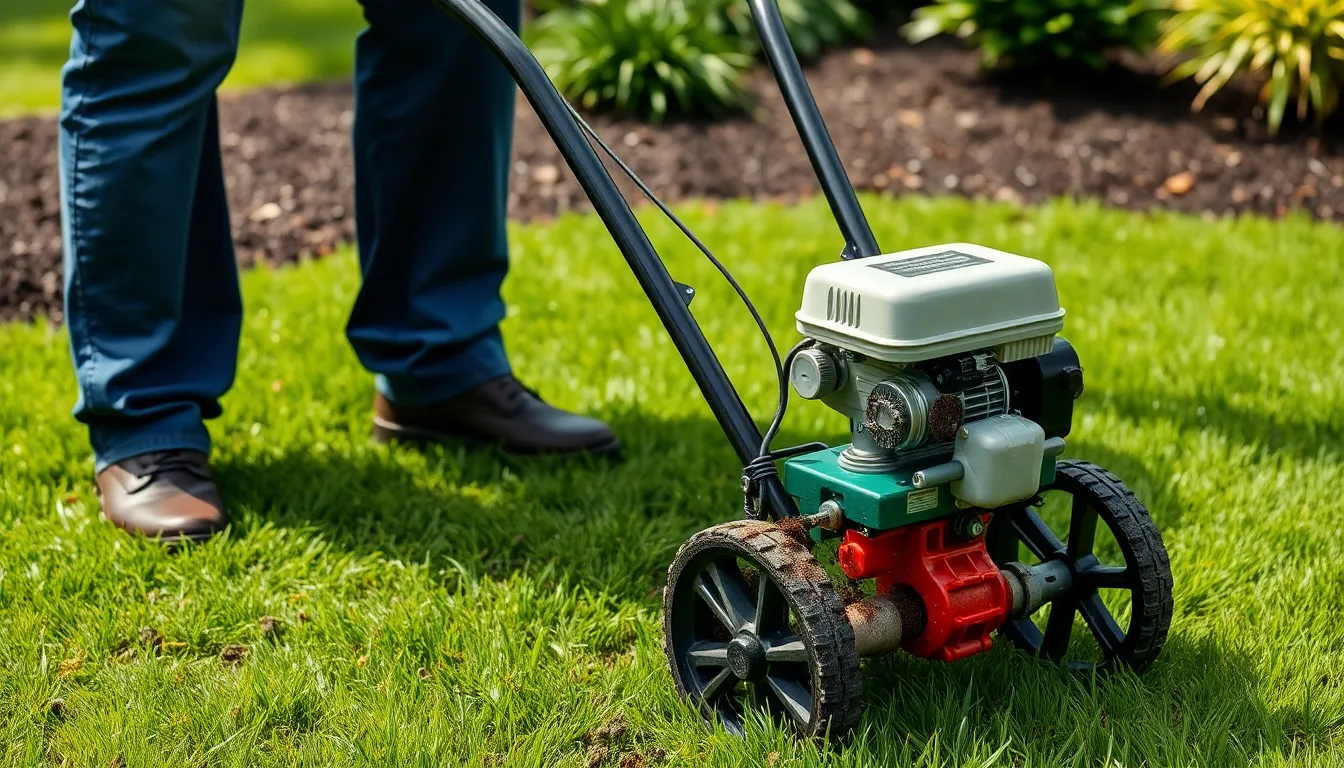Every lawn has its secrets, and one of the best-kept ones is lawn aeration. Picture this: your grass is suffocating under a layer of compacted soil, desperately gasping for air like a fish out of water. Aeration is the miracle solution that helps your lawn breathe, letting nutrients and water soak in like a sponge at a summer picnic.
Table of Contents
ToggleWhat Is Lawn Aeration?
Lawn aeration involves perforating the soil with holes to enhance the flow of air, nutrients, and water to grass roots.
Definition and Process
Lawn aeration refers to the process of creating small holes in the soil. These holes improve soil permeability and allow essential resources to reach the root system. Equipment like core aerators or spike aerators punctures or removes soil cores. Core aeration involves removing plugs of soil, while spike aeration simply pokes holes. The frequency of aeration depends on factors like grass type and soil condition. Typically, every one to three years suffices for maintaining optimal lawn health.
Importance for Grass Health
Healthy grass relies on proper air and nutrient access. Compacted soil limits this access, leading to weak growth. Aeration alleviates compacted soil, significantly improving root development. Enhanced root systems allow grass to absorb water and nutrients more effectively. Overall, regular aeration leads to healthier, more resilient lawns. An aerated lawn also fosters beneficial microbial activity, further supporting grass vitality.
Types of Lawn Aeration

Lawn aeration can be performed in several ways, each offering distinct benefits. Understanding these types helps in selecting the best method for specific lawn needs.
Core Aeration
Core aeration involves removing small plugs of soil from the lawn. This process allows for deeper penetration of air, water, and nutrients. Equipment like a core aerator efficiently extracts soil cores, which can enhance nutrient absorption. Grass thrives as roots gain direct access to the enriched soil below. Optimal timing for core aeration is during the growing season, promoting quicker recovery and growth. Benefits of core aeration include improved soil structure and increased microbial activity, essential for healthy lawns.
Spike Aeration
Spike aeration creates holes in the soil by using a tool with spikes. This method does not remove soil but simply punctures it, allowing for better air exchange. While easier to perform, it is less effective in relieving soil compaction compared to core aeration. Grass absorbs water more effectively, enhancing overall health. Spike aeration is suitable for regular maintenance but may require more frequent applications to achieve desired results. The technique works best when the soil is moist, reducing resistance and maximizing hole depth.
Liquid Aeration
Liquid aeration employs a sprayable solution to break down compacted soil. This method uses a combination of surfactants and soil conditioners to improve soil structure. When applied, these products create pathways for air and water to penetrate. Liquid aeration can be a great alternative for small lawns or areas where traditional methods may be impractical. Frequent applications ensure consistent soil improvement, yielding healthier grass over time. Benefits include less physical disturbance to the lawn and convenience in application, making it an attractive option for busy homeowners.
Benefits of Lawn Aeration
Lawn aeration offers numerous advantages that lead to healthier grass and improved soil conditions. These benefits include enhanced nutrient absorption, better air circulation, and strong root development.
Improved Nutrient Absorption
Aeration significantly improves nutrient absorption by allowing fertilizers and organic matter to penetrate deeper into the soil. Roots access nutrients more effectively, which promotes vigorous growth. Grasses absorb nitrogen, phosphorus, and potassium more efficiently with enhanced soil contact. Microbial activity also increases, further breaking down organic substances into accessible nutrients. This process ensures that essential elements reach grass roots instead of remaining trapped in compacted soil.
Enhanced Air Circulation
Air circulation enhances the lawn’s overall health by allowing oxygen to reach grass roots. Without adequate aeration, compacted soil restricts airflow, leading to poor growth. Proper aeration creates spaces that promote air exchange, vital for root respiration. Increased circulation supports beneficial microbes that thrive in oxygen-rich environments. This improvement helps grass develop a strong, resilient structure, resulting in a lush, vibrant lawn.
Root Development
Root development thrives as aeration allows grass roots to expand and grow deeper. Healthy roots establish a solid foundation for grass, making it more drought-resistant and better equipped to absorb water and nutrients. Aerating the lawn prevents the formation of dense layers of thatch, enabling roots to access moisture efficiently. Stronger roots ultimately lead to better turf density and improved stress recovery during adverse weather conditions.
When to Aerate Your Lawn
Timing plays an essential role in lawn aeration. Understanding the right moments can yield optimal results for grass health.
Seasonal Considerations
Aerating during the growing season is most beneficial for cool-season grasses, typically in early spring or early fall. Warm-season grasses thrive with aeration in late spring or early summer. Each season provides unique advantages, helping to maximize recovery and growth. Avoid aerating during periods of drought or extreme heat, as these conditions can stress the grass further.
Signs Your Lawn Needs Aeration
Several indicators signal the need for aeration. Noticeable soil compaction often leads to poor grass growth and reduced water infiltration. Additionally, if the lawn feels spongy underfoot, that suggests excess thatch. Grass that turns brown or struggles to grow, even after watering and fertilizing, indicates compaction may be limiting roots’ access to essential nutrients. Lastly, patchy areas that fail to bounce back after mowing can highlight areas where aeration could improve overall health.
Lawn aeration plays a vital role in maintaining a healthy and thriving lawn. By alleviating soil compaction and enhancing access to air, nutrients, and water, it promotes robust grass growth. Homeowners can choose from various aeration methods to best suit their lawn’s needs.
Recognizing the right time for aeration and understanding the signs that indicate a lawn’s need for this practice can lead to a more vibrant and resilient outdoor space. Ultimately, regular aeration not only improves the lawn’s appearance but also contributes to its long-term health and durability against environmental stressors. Embracing lawn aeration is a smart investment for anyone looking to elevate their lawn care routine.



